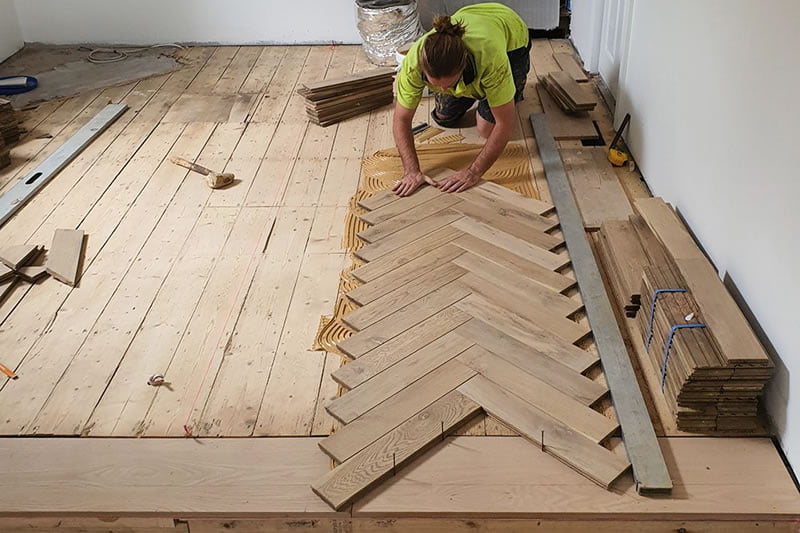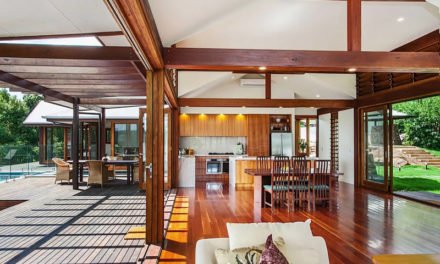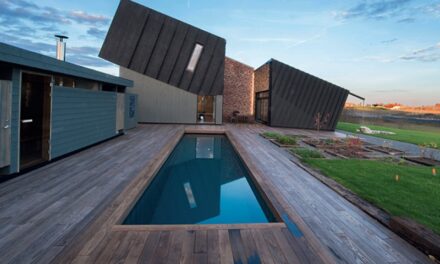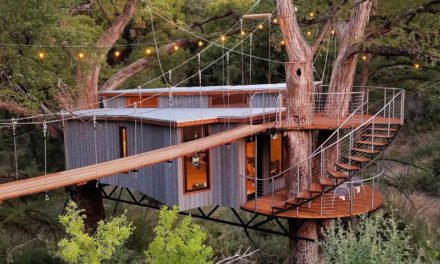It’s economical, sustainable, incredibly durable and can instantly create an interior mood ranging from traditional to utterly modern, so why aren’t more people laying parquet floors?
Hans Unger, owner of Renaissance Parquet, has a lot on his plate at the moment. “We’ve got a near-million-dollar job on in Hong Kong,” he says. “That’s just for supply and consultation. It’s a beautiful floor… and then we’ve got a range of jobs on locally, ranging from huge Toorak showpieces down to suburban homes.”
Hearing that, you’d think parquetry was booming. In fact, it is and it isn’t. “My father was in this business before me,” says Unger. “He came out from Germany after the War and took his joinery training into flooring rather than cabinetry because he realised he could make more money being paid by the metre than by the hour. When I started with our company in 1991, there were about five pages of parquetry firms in the local Yellow Pages, now I know pretty much everyone who’s doing it personally.”
Yet despite the drop in manufacturer numbers, parquetry still makes up about 5% of flooring, roughly the same as 30 years ago. So what’s going on? We spoke with Unger and with Ryan McCarthy, sales and marketing manager at Coffs Harbour Hardwoods for an overview of the sector.
“We’ve only been doing it for 18 months,” says McCarthy, “so we’re still learning and growing. Things we love about parquetry are that we can utilise shorter lengths of timber and the amazing floors that can be created”
Surface and depth
Parquetry makes the most of variations in timber grain and colour to create patterns and movement. Most commonly, natural colour variations within the one species are used, though different species with similar wear qualities can be mixed into patterns.
It’s available in two main types: block and mosaic. Blocks are rectangular pieces of wood cut to specific lengths and sizes. Onsite they are laid into patterns, which can be large and directional, such as herringbones, or more complex ones made up of smaller blocks. These are glued piece-by-piece to a pre-prepared floor surface, which needs to be smooth, dry and stable.
For mosaics, the fingers of wood are arranged and glued onto sheets of flexible backing and then adhered in place as whole units, similarly to tiles.
Block parquets are usually deeper than mosaic, so will stand up to more refinishing, but both have longer lifespans than most modern flooring products.
“We specialise in Australian hardwoods,” says McCarthy. “Rich colours like blackbutt, blue gum, ironbark and brushbox. A lot of the supply is from our own mills on the North Coast of NSW, plus some Tasmanian Oak in from Victoria and some jarrah from WA.”
Parquetry makes good use of boards too small for standard floorboards, or can utilise waste pieces that have been cut between defects. “We can negotiate with the mills to take smaller boards for our parquetry product because we can cut such small lengths, and we run parquets as a waste recovery process from our other flooring lines as well,” McCarthy says. “It’s not as easy to produce as a lot of people might think, the specifications are stringent and the cost in producing it is high.”
At the moment Coffs Harbour Hardwoods is producing a lot of mosaic square on square patterns. “Machinery for cutting chevrons and so on has to be super accurate, so we’re building a market first before we upgrade and purchase equipment for this,” says McCarthy.
Unger has moved away from local timbers in recent years: “We originally had a number of local species. We used flooring rejects from some of them and waste – even from their bins – we just re-machined it on all four sides. But our suppliers shifted to finger-jointing product for the Bunnings market, which cut us off for feedstock.
“Now our oak comes in from Burgundy, France. It’s properly dried, with a lovely patina. It really meets the requirements of the high-end market – a French timber, made properly in Australia. We sell this product all over the world. What you get is consistent – the grading and the drying particularly. And while people are usually happy to pay a little bit more, because of the way the Aussie dollar’s gone lately, it’s currently great value for them.”
Parquetry roadblocks
Customers are attracted by parquetry’s beauty and are happy to learn how affordable it is, with many types costing in the vicinity of $130/m laid. It’s durable (extremely so for some species) and looks good for decades with easy upkeep, but there are two roadblocks for broader uptake.
The first is that some customers think parquetry won’t suit their homes. “They come in looking for floorboards and say offhand that they love parquetry but it’s too dramatic or traditional…” says Unger.
“I show them floors we’ve done and explain what they’re looking at in terms of price and upkeep and they’re amazed. It doesn’t have to be busy or dominant, the proportions can be very calm.”
Customers often return for subsequent houses, with more complex floors, as do their children. Though the longevity of a parquet floor can be an issue for sales. Unger says, “I took my 16-year-old son with me for a job and told him ‘Did you know, your grandfather laid this floor originally in 1960?’ I came and helped him with the upkeep in 1978, when I was five years old, and I’m still caring for that floor in 2020.”
The second roadblock is pricing. Because of enormous differences in the complexity of patterns and cost movements for some timbers, pricing can vary significantly. Parquetry suppliers commonly supply both private and commercial clients, the latter a mix of retailers, designers and builders.
As McCarthy says, “Our pricing can fluctuate depending on the raw material, because Australian hardwoods are reliant on local supply and that’s the biggest cost in our production process. The end user doesn’t mind about the price: they want what they want and they’re happy to pay for it. But the retailers are competing with each other for jobs, so they’re trying to buy it as cheaply as they can to help their margins.”
Unger agrees. His best experiences have been at the very top end of the market and on family homes. “We’ve worked with wealthy owner-builders, but they’ll try to screw you down to a budget. Then we’ll get a house in Park Orchards, three-bedroom suburban, and they’re happy to pay $400 a metre. That was for something really high quality – chevrons with borders and proportional to the house – but they weren’t trying to screw you down to their price because this is their forever home that they want to love and enjoy.”
These homes and top-end commercial jobs provide Unger and his team with the most satisfaction as they get to see the delight from their customers: “We have great relationships with builders like Engelhart Homes and architects including Christopher Doyle. They really understand what the product can do and how to use it.”
That said, the passion for parquetry still sometimes outweighs economics. “There’s a Versailles floor we did,” Unger says, “it’s one of my favourite floors but it was a love job. Even though we charged something like $600 a metre for it, that wasn’t enough. There’s less than 1mm of variation in the face and it was all shaved by hand with a blade, not machined.”
For now McCarthy says Coffs Harbour Hardwoods is concentrating on building a market: “The mosaic gives a better return because the machine we’ve got does a fair bit of the process without human interaction, whereas block has more people involved. The more people, the more labour cost.”
From board to floor
Both companies concentrate on supply, leaving the laying to specialists.
“We do the precision cutting, and they do the precision laying,” says McCarthy. “The specifications are fine and the tolerances are low with a parquetry floor. You only need to be slightly out at one end and you can be a lot out at the other end, so we’re always checking for accuracy and quality.”
For mosaics, the timber fingers are cut by a machine and then go onto a shaker-type belt. “We enjoy watching how the mosaic finger machine works”, McCarthy says. It allows so many boards through one way and then the same the other way which creates the square on square pattern. The team picks through and grades the fingers as they’re going, so anything that might be slightly mis-machined or has a defect, they’ll remove.”
Before this, the timber will have been cut into smaller blocks and left to rest to make sure it won’t move once it’s laid.
At site, there’s just as much care taken. Surfaces are checked for levels and dryness, concrete is sealed and the right adhesive is chosen for the circumstances.
“Some people don’t understand why you’d spend more on adhesives,” says Unger, “But buildings have changed. We’ve got a lot more six-star energy rated buildings where the air will remain very dry and more clients who are very environmentally focused.
“The glues we have on the market now have more options for different applications. Some are low-solvent; there’s no smell, and it doesn’t matter if it gets onto pre-finished product, it just rubs off, but still sticks well to the floor. There are glues that are more rigid – for some parquetry you require something more aggressive to hold it in place – then you’ve got some more flexible ones. It’s a whole system. And I’ve seen floors go badly because a client didn’t want to spend $600 in glue. We’ve had really good experiences with the Mapei products, and they really stand by their product.”
Most problems with parquetry can be avoided through good preparation and planning: it should always be one of the last things done on site in a new build to avoid damage by other trades. “And take photos,” says Unger. “We had one bad client who didn’t want to pay and he was saying it wasn’t compliant because we hadn’t cleaned and prepped the slab, but we’d worked with the installer to document each step.”
Disasters such as water damage can happen, but in many cases things aren’t as bad as they look. In a worst-case scenario, it’s often possible to repair just a section of floor, saving the rest, and sometimes time will fix it. “We had one case where we said to the owner, ‘Can you live with it for 16 weeks?’” Unger says. “He trusted us, so he waited for it to dry out and none of it lifted. We gave it a light refinishing and you’d never know there’d been a problem.”
Both McCarthy and Unger are investing in the future of parquetry. “We’re looking at precision cutting machines that will let us do more shapes,” says McCarthy.
For Unger, the Hong Kong job at the new M+ museum is a focus, and not just because he’s moved from consulting to also supplying. “I showed them how the job could be done more economically, but overall, it’s a $3 million floor,” he says. “It’s end-grain parquetry, so it’s like a butcher’s block. The architect let me loose with the finishing, so instead of sanding it, I’m using a grinding machine with wire in it to strip the grain out, wire brush it and then natural finishing. It looks like a bleached, sandy texture across the floor – it’s incredible. I’ve got almost 1600m2 to do like that, there’s half a million pieces in the floor.”
For more details, visit www.coffshardwoods.com.au and www.renaissanceparquet.com
Image: Parquetry can be laid onto any stable, dry floor surface including timber. Photo courtesy of Renaissance Parquet.











